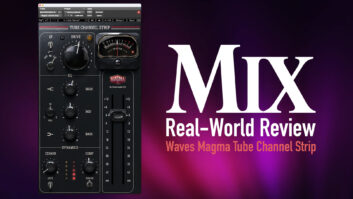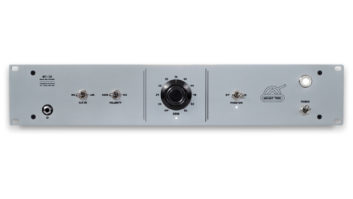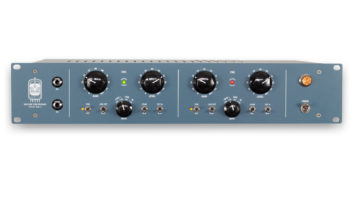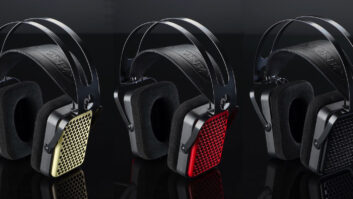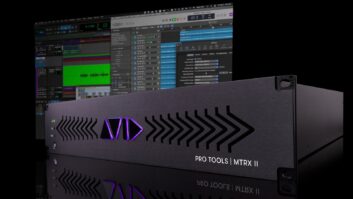It seems that MindPrint has the seven-year itch. Based on the success of its EN-VOICE Class-A mic preamp, which launched in 1998, the company has now released the MK II, an improvement on the original in many important areas.
With a few design upgrades, the original equalizer and tube circuitry remain the same, while the input section has been redesigned, including an integrated balanced insert and some handy compressor presets. MindPrint states that the redesigned switched-mode power supply delivers a solid 250 volts for tube stability and consistent sound. At home on a desktop or in a rack, the MK II comes loaded with useful features.
SMART LAYOUT, SLEEK CONTROLS
The attractive red front panel, silver control knobs and clear plastic function buttons (which light up a very cool blue when active) let you see at a glance how the unit is functioning. All 14 control knobs have a solid, smooth feel, with easy-to-grasp tops that let you get right in there for tweaks without disturbing the rest of your settings — no mean feat in a single-rackspace package this crammed with features.
The input section contains a TRS instrument/line input (mic and line inputs are on the rear) with two pots for input trim (line and mic, respectively) and a clever three-way selector switch for mic, line or instrument. Phantom powering and a -20dB pad switch are also on the front. Mic input impedance is a surprising 10k ohms. Two lighted switches complete this section: one for metering selection and one for low-cut (80Hz) activation. (The rear panel’s insert TRS jacks function in tandem with this section and the USB interface.) The selectable metering view is handy: You can monitor input or output here, with an easy-to-see green/yellow/red LED for keeping an eye on levels at either end of the chain.
The three EQ (LF, MF, HF) sections all have level and frequency controls, while the mid section also includes a third control for changing the size of the mid-frequency EQ’s bell curve, ranging from a third-octave to six octaves. (The EQ shape is a unique design: Low-frequency control covers 20 to 300 Hz, MF covers 100 to 11k Hz, and HF is 1.6 to 22 kHz.) Each section has its own in/out lighted switch — another great at-a-glance feature when working with so many parameters.
The compressor section — based on a 12AX7A triode circuit (with its own hardwired in/out lighted switch) — has the usual controls for threshold (+2 dB to -28 dB), ratio (1:1 to infinity), a gain reduction LED and a tube saturation control. (You can dial in 0 percent to 100 percent.) Tube saturation levels are easily visible with a three-color Tube Sat LED, letting you see and hear the effect: Yellow is a clearly audible; when it’s red, you really know it has kicked in.
The sidechain path has a 6dB/octave cut starting at about 300 Hz, which is activated via a lighted hardwired I/O switch. This really helps reduce any pronounced low-end compression adversely affecting the compression on highs and mids. Lastly, there are eight presets for quick and useful settings, depending on the program material. These are excellent places to start; you can also sweeten to taste after you’ve dialed them in.
CLEAN, BRIGHT, WARM AND FUZZY
I put the MK II through a series of successful torture tests with everything from bass guitar to drums to guitars and vocals in a live band tracking session. I was particularly pleased with the kind of bass guitar sound achieved with very little tweaking. A bass amp cabinet miked with an Electro-Voice RE-20 routed through the MK II using preset “Bass 2” produced a smooth, detailed, lush bass, with a round, warm sound. The compression was barely noticeable, yet the bass retained fullness and punch that used to take me forever to accomplish with other more complex gear.
Kick and snare drums had the kind of detail, clarity and headroom I needed. It won every time it was A/B’d against other preamps and console inputs at my disposal. Whether as a clean preamp or crunchy tube warmer-upper, the MK II is impressive.
While you can simply track the MK II’s analog outs into your own converter, the DI-MOD card USB add-on (a DI-MOD 24/96 with optical and co-ax S/PDIF, master and slave modes, and analog insert is $349) is the finishing touch in using this box with a laptop or desktop computer. The drivers loaded smoothly, and the unit seamlessly works with any Windows or Mac DAW application. Audio data flows via a USB connector at 16 or 24 bits up to 96k, all adjustable via the driver settings. A sync LED lets you know things are working properly, and a S/PDIF output lets you feed DATs and other digital sources without a computer. A clever dual-purpose monitor mode switch allows your choice of stereo playback (from the host computer) with headphones or use as a final insert point for another processor or outboard device input.
SO WHAT’S THE SCOOP?
The EN-VOICE MK II is a tough box to define. Calling it a channel strip is a good start, as it does all that and more, yet it’s also incredibly useful as a stand-alone preamp for vocals, voice-overs and more. It’s rare to find a unit that does everything so well, so cleanly and so smoothly. At a combined price of just less than $1,000 for the unit and the DI-MOD, the MK II is worth looking into for private or pro use. Defing categorization, in this case, is a really good thing.
Prices: basic unit, $799; optional USB I/O, $299.
Mindprint, 847/439-6771, www.mindprint.com.
Joe Hannigan runs Weston Sound & Video in Philadelphia.
